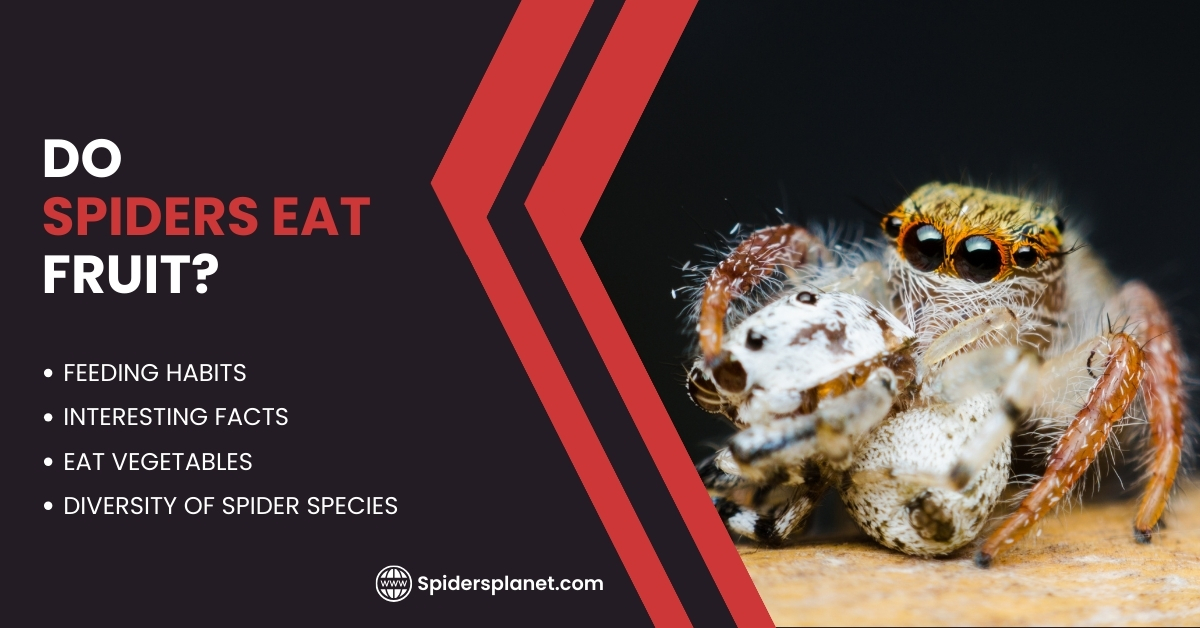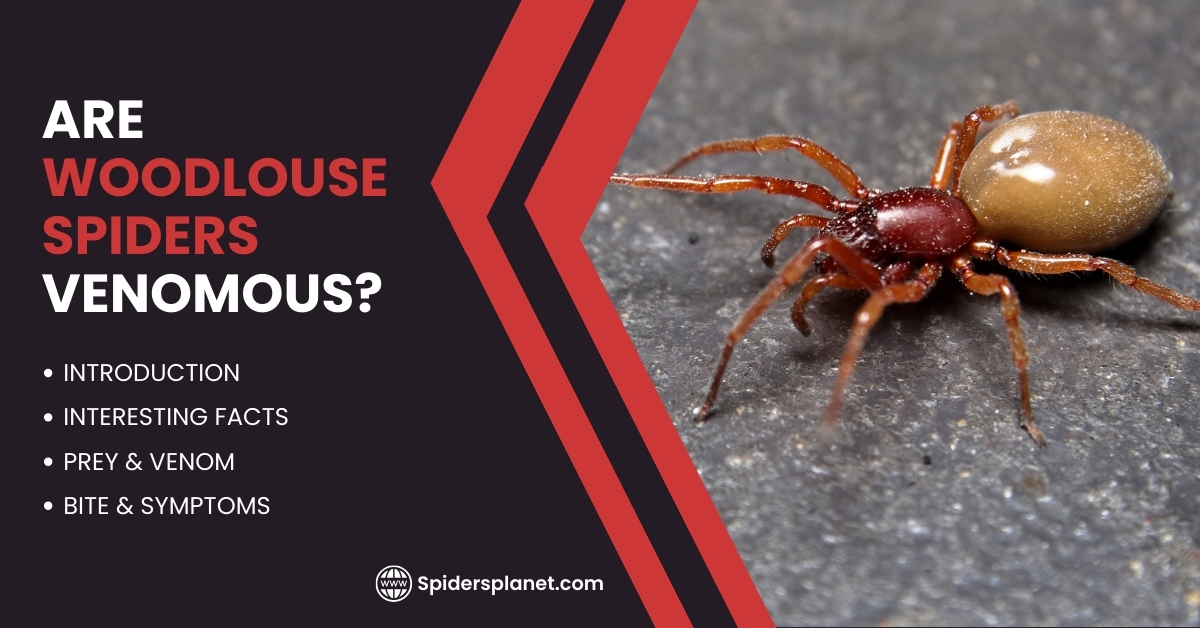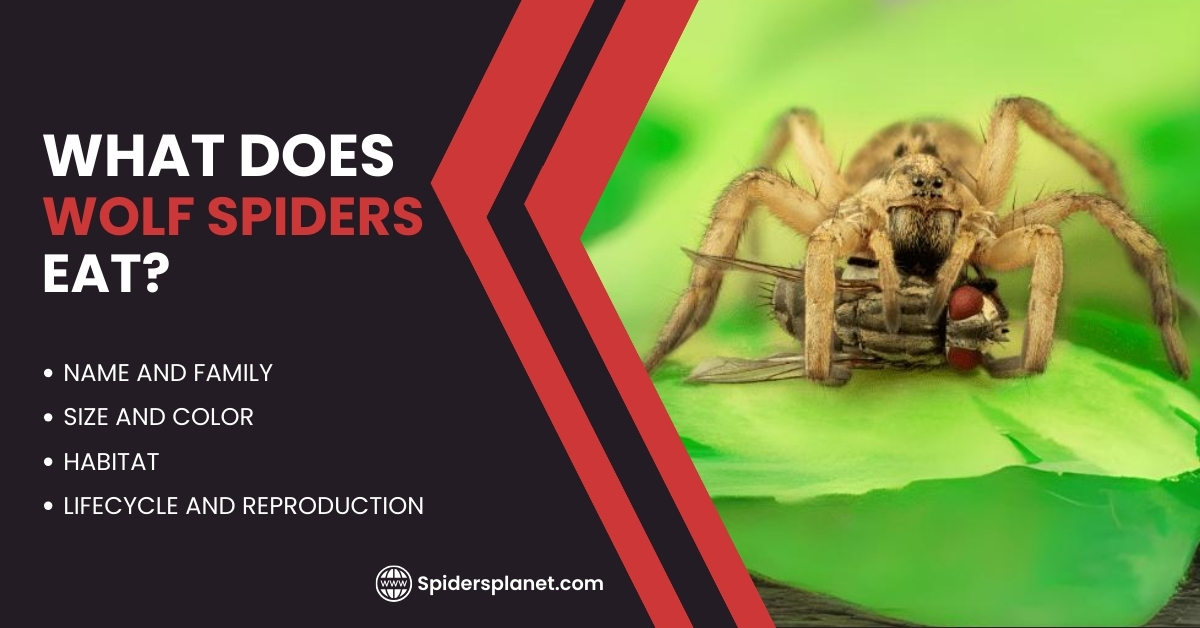Why Do Spiders Have 8 Eyes? Most spiders have eight eyes, which tend to be arranged into two rows of four on the head.
These eyes are categorized by their location and described as anterior median eyes (AME) or anterior lateral eyes (ALE). And then posterior median eyes (PME), and posterior lateral eyes (PLE).
This is an adaptation that has evolved over time to help spiders survive and thrive in their environments. However, have you ever wondered “why” spiders have so many eyes? And more importantly, what purpose do they serve?
Well, in this blog post, we’ll uncover the truths behind spiders’ mysterious anatomy: discussing both the evolutionary reason for their additional pairs of eyes as well as some key facts about how spider vision works.
Quick Facts About Spider Eyes:
Here are some cool things to know about spider eyes:
- Spider eyes are simple, having just one lens and a single retina. This is unlike our eyes, which are more complex with multiple lenses and retinas.
- Spiders can not focus their eyes like we do, so their view of the world is kind of blurry.
- Unlike humans, some spiders can see ultraviolet light.
- Spider eyes are super sensitive to vibrations, helping them sense both prey and potential threats.
Do Spiders Have 8 Eyes?
Spiders have different kinds of eyes that are set up in various ways and serve different purposes.
Normally, they have eight eyes, and each eye is simple with just one lens, not like the compound eyes of insects that have multiple parts.
The way the eyes are arranged, and their structures help scientists tell apart and classify different spider species.
Most spiders with a group called haplogynes have six eyes, but some can have eight, four, or even just two eyes.
Certain spiders that live in caves do not have any eyes at all. Certain spider groups exhibit variations in eye development, where one pair may be more advanced than the rest.
Among hunting spiders like jumping spiders and wolf spiders, a notable trait is their generally keen eyesight.
Specifically, jumping spiders, renowned for their visual acuity, often possess the ability to see in color, particularly through their primary pair of eyes.
Types of Eyes in Spiders: Basic Arrangement:
Spider eyes are really interesting and special parts that help these eight-legged creatures explore their surroundings.
Most spiders have 8 eyes, arranged in two rows of four on their heads. These eyes can be divided into four groups based on where they are:
Anterior median eyes (AME):
These are the two smallest eyes in the center of the front row. They help spiders sense light and dark and figure out their position in space.
Anterior lateral eyes (ALE):
These are the bigger eyes on each side of the AME. They give spiders some depth perception and allow them to see things clearly in front of them.
Posterior median eyes (PME):
These are the second smallest eyes in the center of the back row. They help spiders notice movement and changes in light.
Different spider species have different arrangements and functions for their eyes.
For example, jumping spiders can see really well in front because of their big, movable front eyes, while wolf spiders do not see as well but use their sense of touch for hunting.
The main eyes (principal eyes) are always the front middle ones, and the other eyes are called secondary eyes.
In species with six eyes, the main eyes are the ones missing. Here is the description in the next section for both.
Posterior lateral eyes (PLE):
These are the largest eyes on each side of the PME. They give spiders the best vision, including some ability to see colors and what’s happening behind them.
In most spiders, the main eyes are better at seeing things clearly, but they are not as sensitive as the other eyes.
Unlike the secondary eyes, the main ones do not have a tapetum (a reflective layer), and their retina is turned outward, facing the incoming light.
Some spiders can move their retina using muscles, giving them a broader view. These eyes do not focus like ours because their small lenses and short focal length naturally give them a wide view without needing to focus.
If a spider can see colors, it is usually the main eyes doing the job.
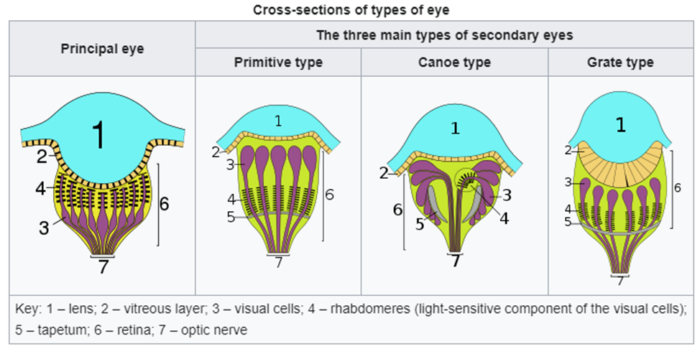
Main Eyes in Spider:
Secondary or Other Eyes:
The other eyes, called secondary eyes, have a different setup. Their retina is turned inward, away from the incoming light. They usually have a tapetum made of crystals, often guanine.
The sensitivity of these eyes is essentially doubled because the light passes through the retina both before and after being reflected by the tapetum.
The tapetum’s structure varies between spider families and groups, and it can be used as a way to tell them apart. There are three main types:
Primitive-type tapetum: This fills the entire eye cup, leaving holes only for nerves. It’s mainly found in less advanced spiders like haplogyne, Mesothelae, and Mygalomorph.
Canoe-type tapetum: This has two walls with a gap in the middle where nerves exit. It’s found in various spider families, including Theridiidae, Clubionidae, and Amaurobiidae.
Grate-type tapetum: This is the most efficient, creating a sharp and focused image. It forms rows of crystals beneath the visual cells, and nerves exit through gaps in the ‘grate.’ Hunting spiders like wolf spiders and fishing spiders primarily have this type.
Why Do Spiders Have 8 Eyes?
So why do spiders need so many eyes? Well, it turns out that each pair of eyes serves a different purpose.
The larger, front-facing pair of eyes, called the principal eyes, are used for detecting motion, while others are used for seeing in low-light conditions.
All eight eyes work together to give the spider a near 360-degree view of its surroundings, making it easier for them to hunt down their prey.
By having multiple sets of eyes, spiders are able to gather a more comprehensive understanding of their surroundings, giving them a distinct advantage in hunting prey and evading predators.
Most spiders having eight eyes can be explained by several beneficial factors. Firstly, having eight eyes grants spiders an extensive field of vision, almost 360 degrees, enabling them to adeptly navigate their surroundings, detect prey or predators, and steer clear of obstacles.
Each pair of eyes serves a distinct purpose, with specialized functions such as light detection, depth perception, movement detection, and high-quality vision.
This specialization allows spiders to process diverse visual information simultaneously, enhancing their overall awareness.
The eight-eye configuration compensates for the limited head movement in spiders, providing a broader view without the need for physical adjustments.
Over millions of years, this evolutionary adaptation has proven crucial for various aspects of spider survival, including hunting, escaping predators, web-building, and navigating diverse environments.
It is important to note that while eight eyes offer significant advantages, some spider species prioritize other senses like touch, vibration, or smell for survival in their specific habitats.
The prevalence of eight eyes in spiders represents a successful and versatile adaptation, contributing significantly to their survival and ecological success.
Can Spiders See Through All 8 Eyes?
With so many eyes, you’re probably wondering if they can see through all of them at once. The answer is yes! but not in the way that you may think! Each of the spider’s eight eyes has a unique function and not all of them are used for clear vision.
For example, most spiders have two large front eyes, called the anterior median eyes (AME), which are used for high-resolution vision.
The other six eyes are anterior lateral eyes (ALE) posterior median eyes (PME), and posterior lateral eyes (PLE) which are typically smaller. These eyes are used to detect motion and are more sensitive to light than the AME.
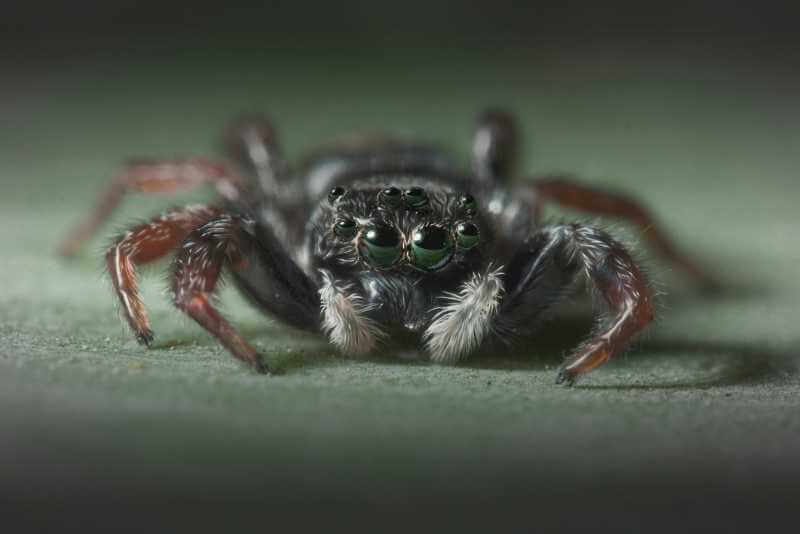
Do All Spider Species Have 8 Eyes?
One common misconception is that all spiders have eight eyes. While it’s true that many spider species have eight eyes, not all do. Some spiders have only six, four, or even two eyes.
But, despite the variation in the number of eyes, spiders are still highly skilled hunters, using their sense of touch and other senses to navigate and catch prey.
Around 90-99% of them typically have eight eyes, there are exceptions worth noting. Some spiders break the eight-eye norm; examples include the brown recluse spider and certain Sicariidae members, which have only six eyes arranged in three pairs.
Certain cave-dwelling spiders in the Dysderidae family make do with just four eyes. Species like Leptoneta manage with only two eyes, which are often small and non-functional.
Moreover, there are spiders adapted to cave life that have no eyes at all, relying on senses like touch and vibration instead.
Interestingly, it is worth noting that even within a single spider species or group, there can be notable variations, and the number of eyes can vary; for instance, some Cybaeidae family members have eight eyes, while others have six or two.
Therefore, while the standard for spiders is eight eyes, the variety extends to their vision, with some using fewer eyes or different sensory strategies.
Types Of Spiders That Have 8 Eyes
So we know not all spider species have eight eyes! However, there are still several species of spiders that have eight eyes including Net-casting spiders (Deinopidae). Here a just a few of the most common spider species that have eight eyes:
- Wolf Spiders
- Fishing Spiders
- Jumping Spiders
- Black Widows
Despite the extra set of eyes, these spiders still primarily rely on their sense of touch and vibration to navigate their environment and hunt for prey.
Can Spiders See Color?
In contrast to humans, who possess trichromatic vision with three types of cones: red, green, and blue, many spiders have dichromatic vision, meaning they have only two types of cones.
They mainly perceive green and ultraviolet (UV) wavelengths. While they cannot see the full spectrum, this ability helps in tasks like detecting prey (insects and flowers reflecting UV light), camouflage (blending with UV markings invisible to us), and navigation (using UV light to move through shaded areas).
Not all spiders have the same color vision. Jumping spiders, for instance, possess more intricate eyes that enable them to detect a broader spectrum of colors, including blues and certain shades of red.
On the other hand, spiders like wolf spiders rely more on touch and vibration for hunting. In summary, spider eyes and color vision offer a captivating glimpse into their unique sensory world, providing a different perspective crucial for their survival and success.
Why do spiders have 8 eyes but Limited eyesight?
Spiders typically have eight eyes, but not all of them have excellent eyesight. Many spiders can only perceive changes in light and dark, lacking detailed vision.
This limited eyesight is sufficient for activities like building webs at night, hunting, and exploring their surroundings. The primary purpose of their vision is to quickly detect changes in light intensity, which aids in nocturnal activities.
For instance, spiders can react promptly to movements, facilitating swift responses to potential threats, such as dropping from webs to avoid daytime predators.
Despite not having sophisticated eyesight, spiders have adapted their vision to suit their specific needs in survival and daily activities.
Can Spiders Still Function If They Lose An Eye?
Yes, spiders can still function if they lose an eye. Spiders have multiple sets of eyes that serve different purposes and they use these eyes differently than humans do.
For example, some spiders have fewer or even no eyes but are still able to hunt and stalk prey, as they have other adaptations to find food.
In certain spider groups, there has been a loss of eye pairs over evolutionary time, including the loss of principal eyes in some species. Despite this, these spiders are still able to survive and carry out necessary functions.
Interestingly, studies have found that the size and position of eyes are key variable traits in spiders, with different families exhibiting extreme enlargement and even loss.
Despite such variations, spiders remain effective hunters and survivors in their respective environments.
However, it’s important to note that the loss of eyesight can also be affected by factors like hunger. A study revealed that spiders can start to lose their eyesight if they get too hungry.
Conclusion
So now you know why spiders have eight eyes! If you found this article helpful don’t forget we have plenty more like this, simply navigate to our home page. There you can find a list of categories including different spider species.

